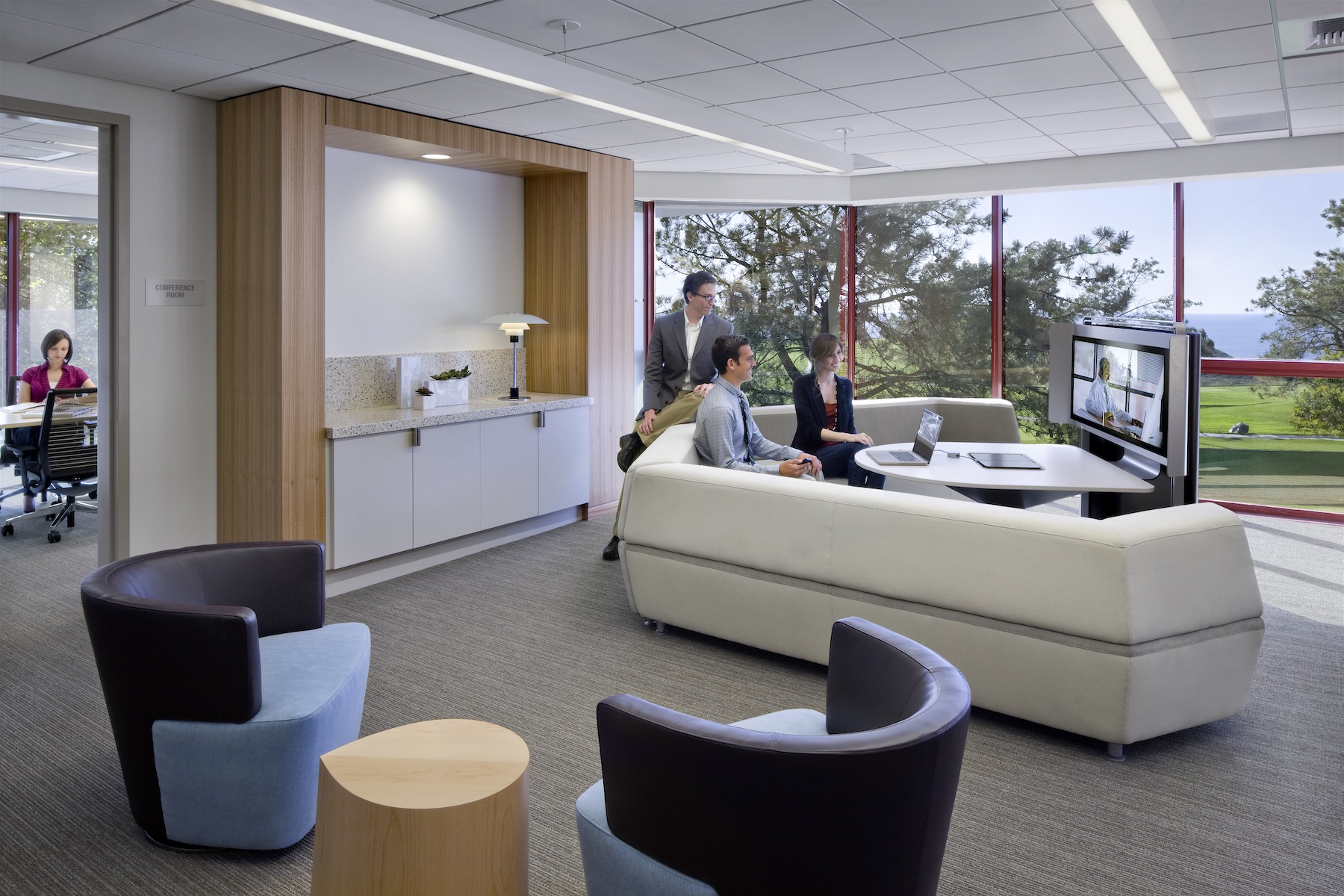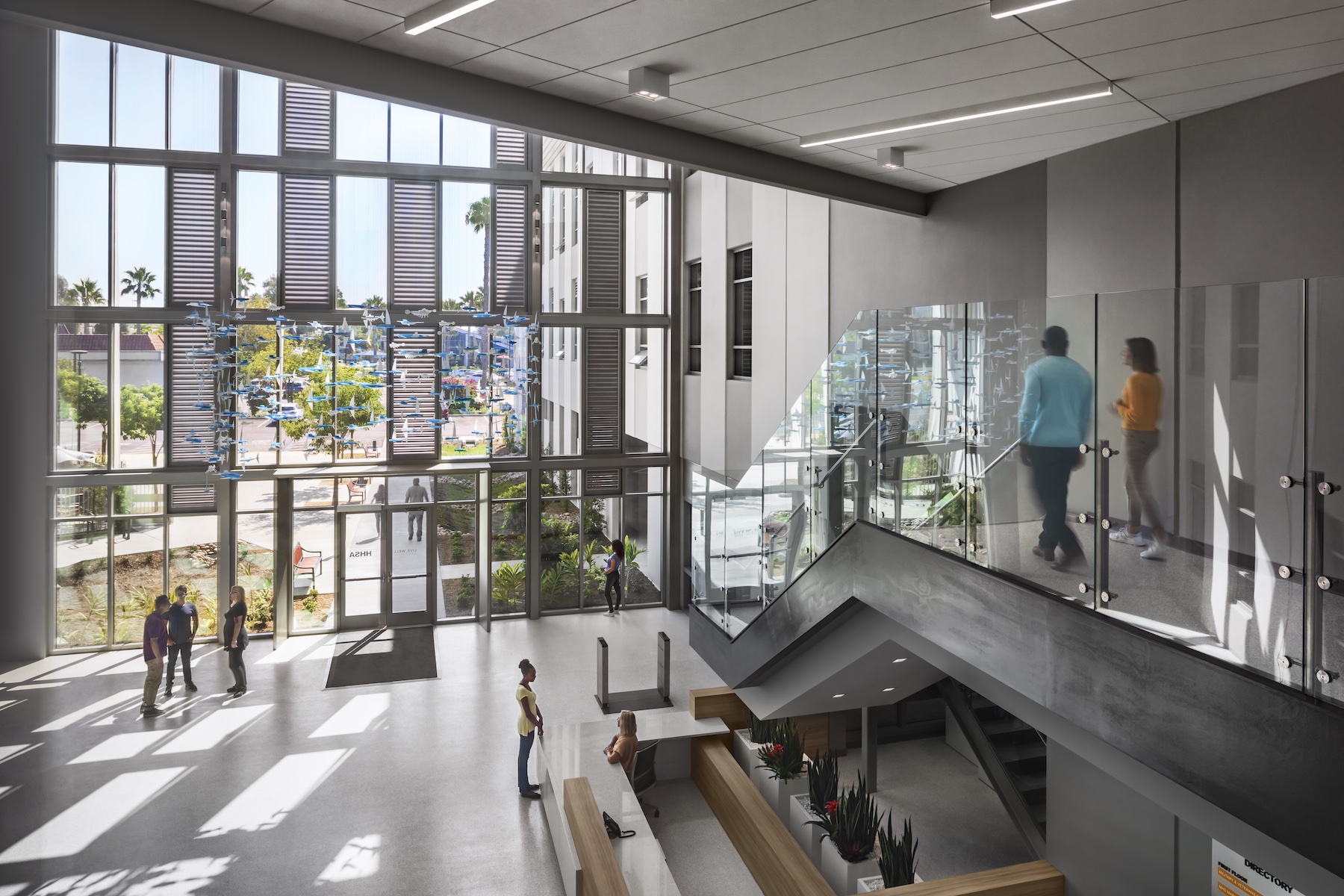The wake of the coronavirus pandemic has presented an opportune moment to re-evaluate and renew physical workplaces as employees return to them.
“The link between good workplace design and productivity is unmistakable,” states HMC Architects in its recently released report, titled “Designing for Wellness and Good Governance,” which focuses on design work done for public-sector clients by the firm’s six studios in California.
The report’s authors note that workplace design for the public sector comes with challenges. “As today’s office landscape becomes less hierarchical and younger staff more interested in a collaborative environment, employers must evolve to meet the needs of the next generation. Public optics, safety, many departments, and unique bidding processes must be considered.”

Those challenges are compounded by the shifting toward hybrid work and how offices must now function. “We are leaving behind a workplace that operates like a machine, where roles and responsibilities are clearly defined and predictable,” the authors write. “Our new future is a workplace that functions like an ecosystem and requires adaptability and unpredictable roles and responsibilities.”
The 28-page report, which can be downloaded from here, aims to present a “blueprint” to craft workplaces “that transcend functional utility and metamorphose into nurturing hubs of growth, connectedness, and mutual success.”
A holistic approach to wellness design

HMC Architects spells out what offices need to be doing today, starting with empowering people to do their best work. Cost-effective environments that blend flexibility, health, and wellness have a better chance at attracting new talent, enhancing employee satisfaction, and fortifying retention rates.
“Wellness is good business,” states the authors, pointing to studies that show that employee absenteeism is reduced, productivity increases, and employee turnover is significantly reduced. “Employee health and wellness investments make people feel valued and often encourage them to invest in their physical and mental well-being.”
However, creating a healthier work environment does not necessarily mean relocation or a complete revamp of existing space; there are cost-effective changes that can have significant impacts, such as bringing in new furniture and lighting for better comfort, temperature, mood, openness and flexibility. HMC says that prioritizing occupants’ thermal comfort is a “cornerstone” of a productive and content working environment
HMC’s solutions are holistic, encompassing the nurturing of wellness through healthier in-office nutritional choices and amenities such as fitness centers, private respite rooms, and access to outdoor recreational areas. “Investing in these purposeful amenities underscores a resolute commitment to cultivating a work environment that is supportive and engaging,” the report states. “Such an environment reflects a genuine concern for the welfare of employees.”
Case studies showcase different design approaches
The report homes in on seven public-sector “case studies” throughout California that amplify some of its general wellness points:
•The County of San Diego North Coastal Live Well Health Centers, whose interior design takes advantage of daylight and fresh air;
•The University of California San Diego North Torrey Pines Living and Learning Neighborhood, whose design balances privacy and collaboration in office spaces;
•Kaiser Permanente’s Fontana Medical Center, a Medical Office Building whose interior design includes biophilia inspired by nature;
•Riverside Office of Education Conference Center, whose design (elevates collaboration and comfort to encourage success;
•Los Angeles County Department of Public Works’ landscape Improvements that include a wellness garden which redefines the workplace experience;
•Mammoth Lakes Civic Center that reshapes the city hub; and
•The Ontario City Hall Annex that creates an office oasis. Along the building’s periphery, open office ergonomic workstations bask in daylight and offer glimpses of the outdoors, facilitated by intelligent sun control mechanisms that subdue glare. Internal offices, adorned with generous glazing, harness natural light cascading within.

The Riverside case study is an example of how design brings disparate elements together. The building’s ground floor serves as nexus for communal engagement, with an interplay between indoor and outdoor spaces. There’s a fusion of private space and open workspaces, and an expansive conference room within the building’s core. Overhead glass and sliding doors unveil a terrace that extends the conference space to an inviting outdoor area, commanding panoramic views of the neighboring landscape.
Related Stories
| Oct 18, 2011
Dow Building Solutions invests in two research facilities to deliver data to building and construction industry
State-of-the-art monitoring system allows researchers to collect, analyze and process the performance of wall systems.
| Oct 17, 2011
Big D Floor covering supplies to offer Johnsonite Products??
Strategic partnership expands offering to south and west coast customers.
| Oct 17, 2011
Schneider Electric introduces UL924 emergency lighting control devices
The emergency lighting control devices require fewer maintenance costs and testing requirements than backup batteries because they comply with the UL924 standard, reducing installation time.
| Oct 14, 2011
AISC develops new interoperability strategy to move construction industry forward
AISC is working to bring that vision to reality by developing a three-step interoperability strategy to evaluate data exchanges and integrate structural steel information into buildingSMART's Industry Foundation Classes.
| Oct 12, 2011
Vertical Transportation Systems Reach New Heights
Elevators and escalators have been re-engineered to help building owners reduce energy consumption and move people more efficiently.
| Oct 12, 2011
Building a Double Wall
An aged federal building gets wrapped in a new double wall glass skin.
Office Buildings | Oct 12, 2011
8 Must-know Trends in Office Fitouts
Office designs are adjusting to dramatic changes in employee work habits. Goodbye, cube farm. Hello, bright, open offices with plenty of collaborative space.
| Oct 12, 2011
FMI’s Construction Outlook: Third Quarter 2011 Report
Construction Market Forecast: The general economy is seeing mixed signs.
| Oct 11, 2011
Pink light bulbs donated to Society of Memorial Sloan-Kettering Cancer Center
For every Bulbrite Pink Light Bulb that is purchased through the Cancer Center Thrift Shop, 100% of the proceeds will be donated to help support breast cancer research, education, screening, and treatment.
| Oct 11, 2011
ThyssenKrupp elevator cabs validated by UL Environment
The conclusive and independent third-party validation process is another step toward a green product line.

















